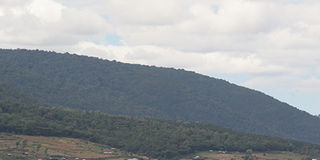Indigenous communities using ingenious ways to conserve the Mau

The Mau forest. Photo/FILE
All over the world, indigenous communities are acknowledged as stewards of forests. Sadly, that’s not the case in Kenya. Here, they are often mistreated by the government for ‘encroaching on forest land’.
But, after years of activism due to illegal evictions, that’s about to change. The Kenya Forest Service (KFS) has found an ingenious way of working with such communities to conserve forest cover in a manner that benefits both parties.
For the last three years, Hilary Ng’eno has been grazing his cows in the open fields around the expansive Mau Forest. At a monthly fee of just Sh100 per cow, KFS allows him access to the grazing fields.
Mr Ng’eno owns a small parcel of land in Kipyosit village, Bomet County, which can hardly support his livestock.
“I have been grazing my cows in the forest. I drive them to the fields next to the forest every morning. They (cows) are a source of livelihood and if I do not care for them, I’ll be doomed,” said Mr Ng’eno.
Chief conservator of forests, Dr Julius Kamau.
In the neighbouring Tegat village, Simon Ng’etich has taken to beekeeping. “I have more than 15 traditional beehives in the forest and I plan to increase the number by adopting modern techniques to improve my earnings,” said Mr Ng’etich.
In Londiani, some villagers have been allowed to cultivate a section of the forest for food crops, such as beans, cabbages and carrots. Betty Ng’eno and her farmhand, Anthony Kirwa, are growing cabbages on a quarter of an acre, on which they have also planted pine seedlings.
Boost forest cover
Welcome to the new forest conservation methods.
KFS and local communities signed an agreement through Community Forests Associations (CFAs) to promote conservation of the Mau by encouraging farmers to plant trees as they cultivate portions of it.
Under the Forest Management Agreements programme, the communities are expected to conserve the forests ‘in a manner that is commercially and environmentally beneficial to them’ and curb its destruction.
The government hopes to boost forest cover from seven to ten percent in its partnership with environmental conservation organisations.
John Mutai, the Masese Nyangores Community Forest Users Association chairman, said the programme had enabled residents to play a big role in the conservation of the forest.
“Cases of illegal logging, charcoal burning and poaching have drastically dropped in the last four years with residents taking a leading role in the protection of the forest,” said Mr Mutai.
The chief conservator of forests, Dr Julius Kamau, said it’s easier to work with the communities to conserve the natural resource. “KFS has signed 103 MoUs (memorandum of understanding) with CFAs across the country in what is expected to increase forest cover and enable the communities to earn a living,” said Dr Kamau.
“Forests are sources of herbal medicine, a habitat for birds and wild animals and a source of wood. The communities living around it should be encouraged to engage in beekeeping as a commercial enterprise,” he added.
An increase in the forest cover would not only help in curbing pollution but also raise underground water levels, ensure rivers and streams are flowing and mitigate the negative effects of global warming. Dr Kamau said 152 participatory management plans (PMPs) had been developed while others were being reviewed.
KFS has developed 12 ecosystem management plans for forest conservation in Mount Kenya, Aberdares, Kakamega and parts of the Mau Complex.
“We want to ensure that restoration of the forest ecosystem is done under sustainable programmes. We can conserve forests in a manner that is beneficial to the communities in the enhancement of livelihoods and creating employment opportunities,” said the KFS boss.
Shamba system
Under the shamba system, farmers are allocated a portion of land in the forest for cultivation while growing trees in blocks that are under rehabilitation. The beneficiaries are then expected to vacate the allocated portions when trees mature.
But the programme has come under focus as some of the beneficiaries are accused of destroying trees, instead of protecting them.
Joseph Kones, a member of the Isei River Water Users Association (WRUA) involved in conservation in Kembu ward, Bomet County, said locals were being encouraged to plant indigenous trees, bamboo and avocado in riparian areas.
“Landowners are urged to uproot eucalyptus trees and plant environmentally friendly ones with high commercial returns,” said Mr Kones.
In the past, there have been conflicts between the government and communities living around forests on the management of the natural resource before participatory forest management plans were developed.
Communities have also urged KFS to allow them to harvest the trees when they mature. “In the past, we have witnessed saw millers from far-flung areas being allocated forest blocks to harvest trees that they did not take part in nurturing to maturity,” said Kericho Governor Paul Chepkwony.
Kericho Governor Paul Chepkwony.
He said the resource should be beneficial to local communities as a source of employment and economic development.
The conservation of the Mau Complex, a regional water tower, has been a major source of conflict between local communities, politicians and KFS. The forest is the source of major rivers and streams that empties its water to Lake Victoria.
The Mara, Sondu and Nzoia rivers owe their existence to the Mau and are the major tributaries of Lake Victoria. The eviction of more than 60,000 families from the forest in Narok a couple of years ago has been a major issue with the victims accusing the government of failing to compensate them under compulsory acquisition rule.
Some government officers also came under the spotlight for being overzealous in the manner they conducted the evictions, disregarding the fact that the landowners had genuine title deeds.
“There is a need to resolve the issues around conservation of the complex and turn it around from a place of despair to one of hope; that it can inspire peace and development,” said Dr Kamau.




